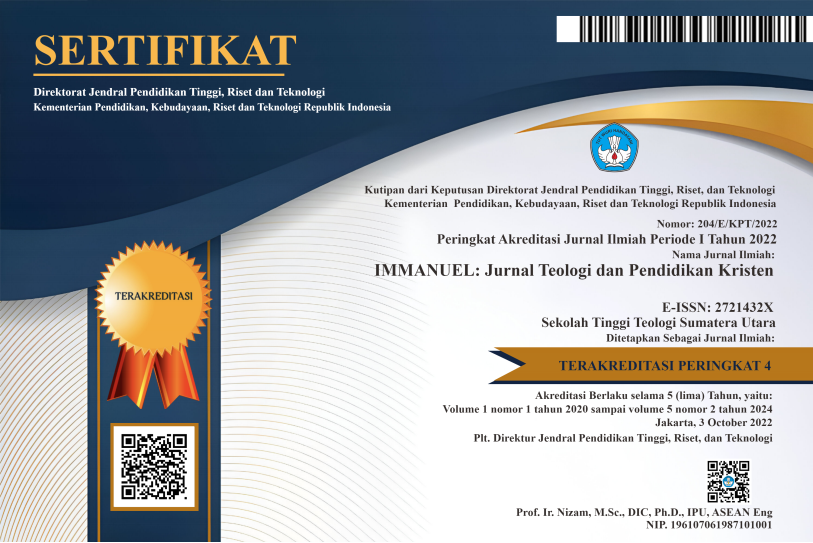Tahun Sabat dan Tahun Yobel dalam Imamat 25
Abstract
The Sabbath and Jubilee years already existed in Ancient Israel, first recorded in Leviticus 25. Explanation is needed in distinguishing the Sabbath and Jubilee in Leviticus 25 from the Sabbaths in other texts. The existence of differences in understanding of the Sabbath such as the value of the Sabbath from only one heart to one year needs to be explained clearly. Using the method of exegesis by looking at the grammar and history of Leviticus 25 is useful for entering into the Sabbath and Jubilee Year laws. The Sabbath and Jubilee laws were used as a period of rest for farmland, farmland, property rights, and debt slaves. The word abaton (שַׁבָּת֥וֹן) is a term to stop all activities at a predetermined time. ten years is often achieved as the fiftieth year, but the Jubilee year lasts forty-nine days, in the seventh month only the tenth of the Israelite calendar.
Abstrak
Tahun Sabat dan Tahun Yobel sudah ada di masa Israel Kuno, tercatat pertama sekali di Imamat 25. Penjelasan diperlukan dalam membedakan Sabat dan Yobel di Imamat 25 dengan Sabat di teks lainnya. Adanya perbedaan pemahaman Sabat seperti nilai waktu Sabat mulai hanya satu hati menjadi satu tahun perlu dipaparkan dengan jelas. Menggunakan metode eksegese dengan melihat gramatika dan historis Imamat 25 berguna untuk masuk ke dalam hukum Tahun Sabat dan Tahun Yobel. Hukum Sabat dan Yobel telah digunakan sebagai masa beristirahat bagi tanah pertanian, pengembalian hak kepemilikan tanah, dan pembebasan para budak hutang. Kata Šabaton (שַׁבָּת֥וֹן) menjadi istilah untuk berhenti dari segala aktifitas pada masa yang telah ditentukan. Kendati Yobel sering dipahami sebagai tahun ke lima puluh, tetapi tahun Yobel hanya berlansung selama empat puluh Sembilan hari, pada bulan ketujuh hari ke sepuluh kalender Israel.
Keywords
Full Text:
PDFReferences
Aritonang, N.J.S. “Panggilan Memelihara Alam.” In Seminar/Pembinaan Warga Di GKPI Satria - Grogol, Jakarta, 1–15. Jakarta: SEKOLAH TINGGI FILSAFAT THEOLOGI JAKARTA, 2020.
Bergsma, John Sietze. The Jubilee From Leviticus To Qumran. Leiden: Brill, 2007.
Chirichigno, Gregory C. Debt-Slavery In Israel And The Ancient Near East. Edited by David J.A Clines and Philip R. Davies. Sheffield: JSOT Press, 1993.
Christophe Nihan. From Priestly Torah to Pentateuch: A Study in the Composition of the Book of Leviticus. Tubingen: Mohr Siebeck, 2007.
David L. Baker. “The Jubilee and the Millennium Holy Years in the Bible and Their Relevance Today.” Themelios 24, no. 1 (1998): 44–69.
———. Tight Fists or Open Hands?: Wealth and Poverty in Old Testament Law. Grand Rapids, Michigan: Wm. B. Eerdmans Publishing Co., 2009.
Elliger, Karl. Perjanjian Lama Ibrani-Indonesia (BHS). Edited by Institute for NT Textual Research Munster Karl Elliger, Willhelm Rudulph. Jakarta: Lembaga Alkitab Indonesia, 2019.
Francis Brown, S. R. Driver, Charles A. Briggs. Brown-Driver-Briggs Hebrew and English Lexicon. Peabody, Massachusetts: Hendrickson Publishers-Snowball Publishing, 2014.
Franz Delitzsch;, Carl Friedrich Keil ; Biblical Commentary on the Old Testament. Franklin Classics, 2018.
Gerhard Kittel & Gerhard Friedrich. Theological Dictionary of the New Testament. Grand Rapids, Michigan: Wm. B. Eerdmans Publishing Co, 1964.
H. F. W. Gesenius. Gesenius’ Hebrew Grammar. Edited by E.; A. E. Cowley Kautzsch. 2nd ed. Oxford: Oxford University Press, 1922.
Hoop, Raymond de, Marjo C.A. Korpel, and Stanley E. Porter. The Impact Of Unit Delimination On Exegesis. Leiden: Brill, 2009.
Jeffrey Stackert. Rewriting the Torah: Literary Revision in Deuteronomy and the Holiness Legislation (Forschungen Zum Alten Testament). Tubingen: Mohr Siebeck, 2007.
John E. Hartley. Leviticus (Word Biblical Commentary). 4th ed. Nashvile: Thomas Nelson, 1992.
Kleinig, John W. Leviticus (Concordia Commentary). St.Louis,Missouri: Concordia Publishing, 2003.
Kristiani, A. B. “Sistem Ekonomi Bangsa Israel Dalam Mengentaskan Umat Israel Dari Mental Miskin (Studi Kitab Imamat).” GENEVA: Jurnal Teologi dan Misi 1, no. 1 (2019): 14–25.
Laoly, Nepho Gerson. “Yobel: Periode, Sosial, Ekonomi, Dan Teologi.” KERUGMA: Jurnal Teologi dan Pendidikan Agama Kristen 3, no. 2 (2021): 1–17. http://sttiimedan.ac.id/e-journal/index.php/kerugma/article/view/60.
Levinson, Bernard M. “The Birth of the Lemma: The Restrictive Reinterpretation of the Covenant Code’s Manumission Law by the Holiness Code (Leviticus 25:44-46).” Journal of Biblical Literature 124, no. 4 (December 1, 2005): 617. https://www.jstor.org/stable/10.2307/30041061?origin=crossref.
Lloyd R. Bailey. Leviticus-Numbers: Smyth & Helwys Bible Commentary. Macon,Georgia: Smyth & Helwys Pub, 2005.
Luthy, C. J. “ἌΦΕΣΙΣ In The New Testament And Its Suggested Links To The Biblical Jubilee.” Jurnal Jaffray 17, no. 1 (2019): 1–18. https://ojs.sttjaffray.ac.id/JJV71/article/view/306/274.
Martin Noth. Exodus (Old Testament Library). Louisville, Kentucky: Westminster Press, 1962.
Milgrom, Jacob. Leviticus 17-22. 3B ed. New York: Doubleday, 2000.
———. Leviticus 23-27. New York: Doubleday, 2001.
Nainupu, M. “Pelayanan Gereja Kepada Orang Miskin.” SOLA GRATIA: Jurnal Teologi Biblika dan Praktika 2, no. 2 (2014): 70–93.
Nobuyoshi Kiuchi. Leviticus (Apollos Old Testament Commentary Series, Volume 3). Wesmont, Illinois: IVP Academic, 2007.
Pakpahan, J. (2022). “Politik Keadilan: Peran Politik Gereja Di Masa Kini.” Jurnal Loko Kada 2, no. 2 (2022): 92–101. https://jurnal.sttmamasa.ac.id/index.php/lk/article/view/28.
Rabbi Moshe ben Maimon. “Mishnah Kilayim.” Chabad.Org. https://www.chabad.org/library/article_cdo/aid/986691/jewish/Kilaayim-Chapter-2.htm.
Rainer Albertz. Israel in Exile: The History and Literature of the Sixth Century B.C.E. Atlanta, Georgia: Society of Biblical Literature, 2004.
Samuel E. Balentine. Leviticus: Interpretation: A Bible Commentary for Teaching and Preaching. Louisville, Kentucky: Westminster John Knox Press, 2003.
Siahaan, Y. Y. “Injil Barnabas Dan Makna Pentingnya Dalam Studi Heresiologi.” Jurnal Teologi & Pelayanan Kerusso 6, no. 1 (2021): 58–71.
Yunus. “Pandemi Covid 19 Dan Kemiskinan; Suatu Prespektif Teologi Kristen.” Voice of Wesley: Jurnal Ilmiah Musik dan Agama 4, no. 1 (2020): 20–33.
Zega, Y. K. “Pelayanan Diakonia: Upaya Gereja Dalam Mengentaskan Kemiskinan Bagi Warga Jemaat.” IMMANUEL: Jurnal Teologi Dan Pendidikan Kristen 2, no. 2 (2021): 88–102.
DOI: https://doi.org/10.46305/im.v3i2.130
Refbacks
- There are currently no refbacks.
Copyright (c) 2022 IMMANUEL: Jurnal Teologi dan Pendidikan Kristen

This work is licensed under a Creative Commons Attribution-NonCommercial-ShareAlike 4.0 International License.
Immanuel indexed by:
Immanuel: Jurnal Teologi dan Pendidikan Kristen
Published: Sekolah Tinggi Teologi Sumatera Utara
Website Institusi: stt-su.ac.id
Address: Jl. Sembada No. 32, Titi Rantai, Kec. Medan Baru, Kota Medan, Sumatera Utara 20131
ISSN: 2721-432X (online), 2721-6020 (print).
















